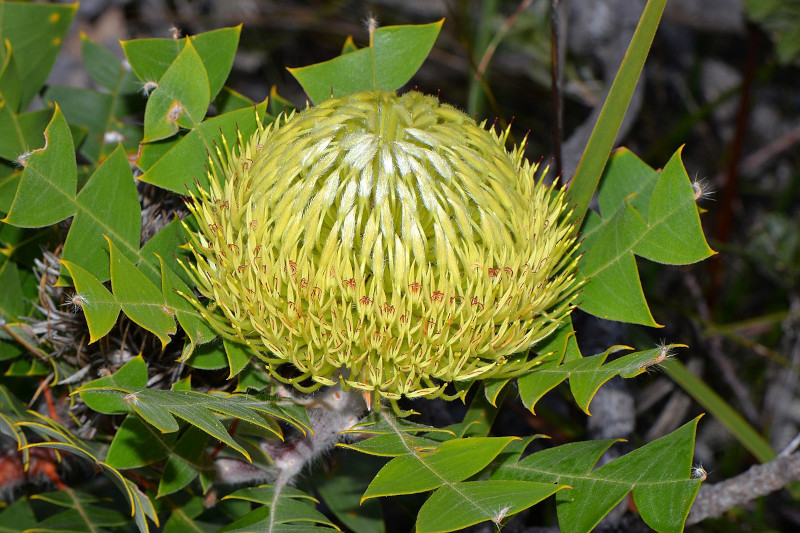
Bird’s nest Banksia Facts
- The most often used common name for this stunning creation of Nature and evolution is the intriguing term of Bird’s nest Banksia. The amazing flora does have at least one other general title, though. That’s the very similar term of Baxter’s banksia.
- Among members of the scientific community, however, it’s probably better known by its technical title. Ironically, though, that’s extremely simple for the layperson to pronounce, and similar to the others. It holds the technical epithet Banksia baxteri.
- The distinctive product of evolution received that designation due to the efforts of Robert Brown. This respected Scottish botanist accomplished the first recognition of it as a separate and distinct species. He managed that noteworthy feat in the year 1830.
- This wondrous Angiosperm earns notice for several reasons. Its unusual shape merits a great deal of notice from many people, for one. Plus, the flora also holds cultural significance for Indigenous Peoples native to region of the world in which it lives.
- Lamentably, the amazing Bird’s nest Banksia now finds itself in a somewhat untenable position. Its population appears to be diminishing. That regrettable state further seems to hold true across its entire range. The IUCN thus now lists it as Vulnerable.
- It faces numerous threats to its continued existence. Like all species on earth today, most of these stem from the actions of man. These include the related perils of habitat loss and ongoing climate change. Yet, it’s also endanged by invasive species.
Related Articles
Bird’s nest Banksia Physical Description
The attention-grabbing Bird’s nest Banksia earns its name due to its unique appearance. This, though, represents only one of the reasons why many who view find it impossible to look away. That’s because the plant also holds many other appreciable qualites.
In terms of pure height, it’s actually quite variable. Generally, however, it develops as either a medium-sized shrub or small tree. In these instances, it typically reaches heights measuring 3.3 – 9.9 ft (1 to 3 m). Nonetheless, in favorable conditions, it may grow larger.
Both the primary stalks of the plant, and the shorter stems share and remarkable trait. That’s the presence of a dense covering of fine hairs. This provides them with a slighty fuzzy or velvety texture. These same sections also tend to be a light brown shade in color.
The leaves of the plant are narrow, elongated, and serrated along the edges. These develop alternately along the stems and vary in length from around 2 – 6 in (5 to 15 cm). The upper surface of the leaves is typically dark green, while the undersides may be lighter in color.
Meanwhile, the flowers remain small and densely packed within the inflorescence. Each flower consists of a tubular structure with four lobes and long styles protruding from it. The color of the flowers varies from creamy yellow to orange or red, depending on the variety.
Yet, it’s the unique inflorescence of the Bird’s nest Banksia itself which usually garners the most interest. This is cone-shaped and closely resembles a bird’s nest. That structure’s formed by many tightly packed flowers arranged in a spiral pattern around a central axis.
The fruit of the species is less dramatic, though. It consists of woody follicles, known as cones. These follicles are ovoid or cylindrical in shape and can measure 1.6 – 3.1 in (4 – 8 cm) in length. Each follicle contains numerous small seeds embedded within woody valves.
- Kingdom: Plantae
- Phylum: Tracheophyta
- Class: Magnoliopsida
- Order: Proteales
- Family: Proteaceae
- Genus: Banksia
- Species: B. baxteri
Bird’s nest Banksia Distribution, Habitat, and Ecology
The intriguing Bird’s nest Banksia evolved as indigenous to only a very small portion of the surface of the earth. Curently, there’s no evidence that it ever existed anywhere outside that range. The location of that zone of habitation likely won’t surprise you, though.
That’s true since this wonder of evolution developed as native to a rather limited portion of western Australia. It is primarily found in the southwestern region of the state, particularly in areas situated either in or around the Stirling Range and the Porongurup Range.
The flora displays very clear preferences regarding its choice of habitat. It typically grows in sandy or gravelly soils, often on hillsides or slopes. It’s also adapted to the Mediterranean climate of the region, characterized by hot, dry summers and cool, wet winters.
It’s also well-adapted to survive at various elevations within its range. The botanical wonder does, however, typically restrict its presence to a band placed within roughly 31 mi (50 km) of the coastline. Here, it thrives in often nutrient-poor, but well-drained, soil.
Bird’s nest Banksia isn’t just a visually captivating species, though. It also plays an important role within its native habitat. Like its relatives, it relies on animals for pollination. Birds, mainly nectar-feeding species such as honeyeaters and lorikeets, are the primary pollinators.
After flowering, the flora produces woody follicles containing seeds. These release their seeds when mature, often in response to environmental triggers such as fire or heat. Ants collect and bury these, aiding in their dispersal and potentially enhancing their germination.
This remarkable woody shrub doesn’t stop there, though. It additionally provides shelter within its ecosystem for various creatures. The dense foliage and woody structure of the amazing plant offer nesting sites and refuge for birds, insects, and small mammals.
Species Sharing Its Range
Check out our other articles on 4 Novel New Guinea Reptiles, Giant Otter, Vikos Gorge, Rose’s Ghost Frog, Southern Stingray, Old World Swallowtail, Eurasian Griffin Vulture, Jewelled Gecko
